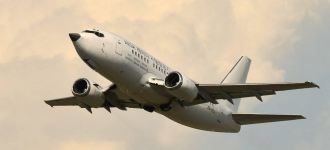South Korea’s 4.5-generation aircraft has a new action. The KF21 nose is installed on a Boeing 737. Why is it modified in South Africa? _Test_Proceed_Avionics System
2021-12-06 04:08:05 Published in International by the Screaming Stuka18
South Korea’s 4.5-generation machine KF-21 seems to have fallen silent for some time after the noise when the first prototype went offline. Many people say that it has been dismantled like a Japanese "Mind", and even the project may be discontinued. . But in fact, disassembling the first prototype on the ground is the only way for countries with weak aviation foundations to develop new types of fighters. It does not mean that it ends here and will eventually have to be reassembled. In fact, the development of South Korea's KF-21 is still proceeding step by step, and even new moves have been made recently.
The development of KF21 is still proceeding step by step

Yes, this Boeing 737 is the latest effort of South Korea’s KF-21. In fact, it has been unveiled as early as the first ten days of November, and the KF-21 airborne active phased array radar has recently been installed in preparation for avionics system testing. Having said that, everyone understands that it is the integrated avionics flight test platform (FTB) of South Korea’s KF-21. It is the same as the international practice. It is modified on a passenger or transport aircraft. It can be used for four takeoffs. Up to 5 hours of testing, more space, longer battery life, and faster test progress.
Boeing 737 before changing the KF21 nose
However, it is interesting that the place where this Boeing 737 appeared is not South Korea, but South Africa, which is thousands of miles away. This can be seen from the topography of the airport, where is such a place like Pingchuan in South Korea? And this is why the KF-21 integrated avionics flight test platform is making its first flight in South Africa. After all, the airspace in Northeast Asia is narrow and the routes are busy. As soon as this Boeing 737 starts up, maybe the entire Seoul Seoul) will be suspended.
KF-21 Integrated Avionics Flight Test Platform
Inside the cabin of this Boeing 737
Display and control terminal of KF21 test platform
On the other hand, the reason is that South Korea's KF-21 has some cooperation with South Africa in terms of electronic systems, and the modification project also requires technical support from South Africa. Although the airborne radar is owned by the domestic LIG Nex1 company, foreign aid is indispensable in other aspects. This is the current reality in South Korea. For example, it is planned to fly the KF-21 Block2 for the first time from 2026 to 2028, and even the buried bomb bay developed by the United Kingdom will be used. However, because South Korea can't handle this system, many sensors will continue to be exposed until KF-21 Block3 can completely solve the problem of the domestically-made embedded bomb bay and reach the level of "Falcon Eagle".
South Korea still can't handle it by itself

The airborne radar is from South Korea’s LIG Nex1
According to the current progress, this KF-21 integrated avionics flight test platform should have achieved its first flight in South Africa. Of course, it will return to Korea for testing in the future. Prior to this, South Korea had already modified a C-130H transport aircraft locally to test the airborne active phased array radar of the Korea National Defense Science Institute and LIG Nex1, and it had also tested the radar beam stabilization function, and measured Ground clutter interference, and conducted air-to-air/air-to-ground model tests.
Previously, South Korea changed a C130H
This way of playing is too amateur
This C130H also tested a lot of things
It's considered to be a native method
However, this method of stuffing the radar with a mobile trolley into the belly of a military transport aircraft, opening the stern door during flight, and pushing the radar out is really unprofessional. That's why this Boeing 737 was born. In fact, when the US F22, F35, Russian Su 57, and my country’s F-20 were developed, there were one or two similar aerial test platforms for avionics. These are key equipment as important as wind tunnels. With the help of South Africa, South Korea It is a preliminary climb to this technology tree. But the problem is that after so many years of reverse elimination, South Africa's own level is no longer good.
F35 radar electronic test platform
F22's avionics test flight platform
According to South Korea, ground testing of the KF-21 No. 1 prototype should begin later this year, and the first flight will be in July 2022. Now that the distance is very close, in the next time, what kind of news it will explode, let's wait and see.
I really don’t understand this picture, so let’s give it to everyone as it is
韩国4.5代机KF-21在经过首架原型机下线时的喧闹之后,近一段时间似乎又沉寂下来了,很多人说它已经像日本“心神”一样被拆了,甚至项目都可能下马了。但实际上,将首架原型机进行地面分解,是一些航空基础薄弱的国家在研制新型战机时的必经之路,并不意味着到此为止,终归还要重新组装起来的。实际上,韩国KF-21的研制仍在按部就班地进行,甚至在最近还搞出了新动作。 KF21的研制工作仍在按部就班地进行 没错,这架波音737就是韩国KF

sunnews.cc








































